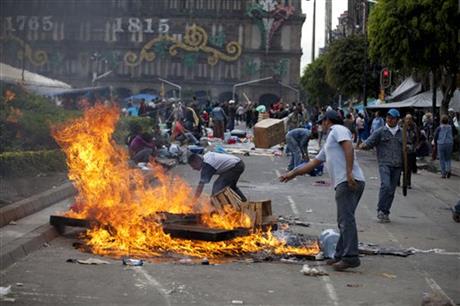
By MARK STEVENSON and ADRIANA GOMEZ LICON
Protesting teachers light a bonfire in Mexico City main plaza, the Zocalo, Friday, Sept. 13, 2013. Thousands of teachers who have camped out at the Zocalo for more than a month have been told by authorities they need to leave today setting the stage for what could be an ugly confrontation culminating weeks of protests against an education reform. As federal police helicopters swooped low overhead Friday, teachers struck tents they have been living in for weeks and burned garbage and plastic traffic barriers, filling the Zocalo with thick, acrid smoke. (AP Photo/Eduardo Verdugo)
MEXICO CITY (AP) — Thousands of striking teachers briefly seized control of the historic heart of Mexico City on Friday, blockading the Zocalo plaza armed with metal pipes and wooden clubs. Minutes after a late-afternoon government deadline, riot police started pushing into the area, firing tear gas and ducking hurled rocks in a confrontation culminating weeks of protests against an education reform.
The teachers used steel grates and plastic traffic dividers to block the streets leading into the Zocalo, home to the Metropolitan Cathedral, Templo Mayor and National Palace, some of the city’s best-known tourist attractions. Hundreds of Mexico City and federal riot police massed on the other sides of the barriers, then swarmed into the square past the famed Aztec temple, chasing down and arresting protesters.
Mexico’s government had promised that Independence Day celebrations, including the traditional presidential shout of independence from a balcony overlooking the square, would take place in Zocalo Sunday and Monday.
The president’s office pointedly released an official schedule in the middle of the protests, noting that the independence “shout” would take place at the National Palace at its usual time Sunday night. Manuel Mondragon, the head of the federal police, warned on national television that police would move in at 4 p.m. local time. The teachers, many veterans of battles with police in the poor southern states where they live, promised not to move from the square where they have camped out for weeks, launching a string of disruptive marches around the city.
Shortly after the deadline, the police swarmed in, shooting tear gas from specially equipped fire extinguishers and tossed flash grenades. Protesters hurled sticks and chunks of pavement broken from the street.
Within a half hour, police had cleared the Zocalo, and much of the surrounding historic center, of virtually all protesters. Union organizers said they would reassemble away from the main plaza.
The teachers have disrupted the center of one of the world’s largest cities at least 15 times over the last two months, decrying a plan that aims to break union control of Mexico’s dysfunctional education system.
President Enrique Pena Nieto dashed the teachers’ hopes of blocking the overhaul when he signed the new system into law Tuesday. On Wednesday, the protests began turning violent, as protesting teachers scuffled with riot police after officers set up a line to keep protesters from blocking one of the city’s main expressways. City officials reported 15 police hurt as protesters seized some plastic riot shields from officers.
The teachers say blocking the reform itself is no longer the point. They say they are now trying to maintain pressure to protect their rights and privileges as the government puts the labor reforms into effect and reduces union control over teacher hiring and assignment.
As federal police helicopters swooped low overhead Friday, teachers struck tents they have been living in for weeks and burned garbage and plastic traffic barriers, filling the Zocalo with thick, acrid smoke. A group of battle-hardened teachers said clearing the tents was a tactical move to allow them maneuvering room for any possible clash.
In echoes of the Oaxaca clashes of 2006, a group of Oaxaca teachers said they had already commandeered a bulldozer from road works in the Zocalo and had moved it to the front lines, to use against a possible police attack.
“We’ve got the bulldozer ready,” said primary-school teacher Cesar Perez, who teaches in the impoverished Sierra Norte mountains of Oaxaca. “The president isn’t going to give the shout here. Here they are going to listen to the people.”
As the teachers waved pipes and cudgels in the air, singing “we will overcome!” actor Pepe Ortiz cheered on the crowd dressed as independence hero Miguel Hidalgo and clutching a big Mexican flag. He brushed off criticism that the protest was preventing the customary shout of independence.
“For me, this is the shout, the shout of the people,” he said, pointing to the singing, chanting throng of protesters. “This is the real shout.”
The protests are being led by the National Education Workers Coordinating Committee, or CNTE, the smaller of the country’s two main teachers unions. The larger union has supported Pena Nieto’s reform.
The teachers argue that the powerful listen only to power, and their main strength is the ability to shut schools and make life inconvenient in Mexico’s economic, political and cultural heart.
Mexico City’s government has avoided intervening until Friday, increasing the frustrations of many of the capital’s residents. The city’s leftist government has historically been slow to crack down on protests, fearful of violence on the capital’s streets. Two massacres of protesting students in 1968 and 1971 became national traumas.
____
Michael Weissenstein and E. Eduardo Castillo contributed to this report.
____



